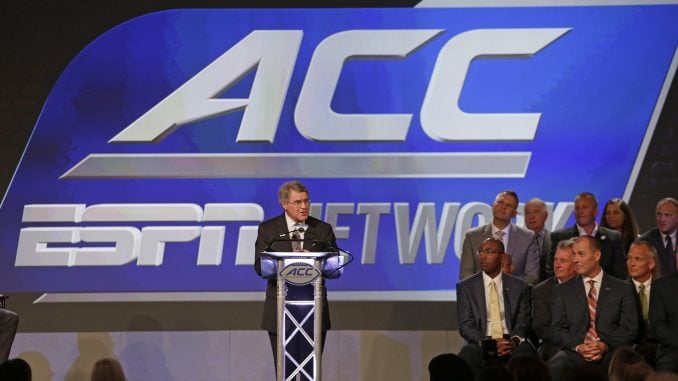
Technically, the long-awaited ACC Network has been up and running for almost three years now. Branded as ACC Network Extra, the digital channel went online in 2016 and has made more than 300 live events per season available to users with access to WatchESPN and the ESPN app.
But that has been a mere prelude to the upcoming main event.
This fall, commissioner John Swofford’s dream will come true with the introduction of a full linear network dedicated solely to coverage of the conference and its 15 member schools.
The ACC Network will formally launch on Aug. 22. One week later, the football game between defending national champion Clemson and Georgia Tech will become the first of 1,300 live events carried annually on the league’s television and digital platforms.
It’s a partnership with ESPN that Swofford said will “allow fans to have greater access (to the ACC) than ever before.”
Although many of the specifics surrounding the new network have not been announced, here are some of the details we do know.
27 sports through 2036
Thanks to the grant of rights signed by each conference school as part of the ACC’s television deal extension with ESPN, the conference holds the broadcast rights to all of its events — in 27 sports — through 2036. It’s an arrangement that guarantees the network a virtually unlimited inventory of events from late August through early June.
In addition to 40 regular season football games, plus a variety of news and information shows and other original programming, the conference plans to televise 150 men’s and women’s basketball games annually, along with 200 other regular season and tournament games in various Olympic sports.
With an eye on maximizing viewership, the conference has rearranged its football schedule to include more early season conference matchups. Swofford has also suggested that the ACC will break with tradition and jump right into conference play on the opening night of the basketball season.
“The thing that’s been really good from our schools is that they’re all-in on the network,” Swofford said. “Everybody understands the importance of scheduling.”
State-of-the-art facilities
The conference plans to hire a personality to be the “face” of the ACC Network, similar to Paul Finebaum on the SEC Network. Although the network will likely be based in Charlotte, each school is in the process of building its own state-of-the-art broadcast facility where they will have the ability to produce their own programming and broadcast games on site.
North Carolina’s $10 million studio is being constructed onto the Koury Natatorium, directly adjacent to the Smith Center. NC State’s $6 million facility is located inside the main entrance of the Wendell H. Murphy Football Center behind the south end zone at Carter-Finley Stadium.
Duke’s setup is located in the Blue Devil Tower at Wallace Wade Stadium and includes three control rooms, personal offices, editing suites and a live studio. And at Wake Forest, a 3,400-square foot command center with linear and digital control rooms has been constructed in the former clubhouse of its Couch Ballpark baseball stadium.
Expected cash influx
Though exact figures will depend on distribution deals between ESPN’s parent company Disney and cable providers to carry the channel, conference officials are counting on the new linear ACC Network to provide a financial windfall that will bring the conference’s income more in line with that of the SEC, Big Ten and Pac 12 — leagues that already have their own dedicated networks.
According to published figures, the SEC’s television revenue increased from $210.4 million in 2013, the final fiscal year without its own network, to $311.8 million following the network’s debut. By 2016-17, the revenue stream had increased to $409.1 million — leading to a payout of approximately $41 million per school.
By contrast, the ACC distributed an average of $26.6 million per school in 2017.
Swofford has steered clear of talking about finances, especially those associated with the ACC Network. But athletic directors such as NC State’s Debbie Yow have made little secret that they’re counting on the new network to be a significant moneymaker for their respective programs.
“The single most important thing for the future of this athletic program financially is the success of the ACC Network, without question,” Yow said last August. “We have to have it just like the SEC and the Big Ten did.”


